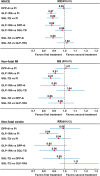The effect of DPP-4 inhibitors, GLP-1 receptor agonists and SGLT-2 inhibitors on cardiorenal outcomes: a network meta-analysis of 23 CVOTs
- PMID: 35296336
- PMCID: PMC8925229
- DOI: 10.1186/s12933-022-01474-z
The effect of DPP-4 inhibitors, GLP-1 receptor agonists and SGLT-2 inhibitors on cardiorenal outcomes: a network meta-analysis of 23 CVOTs
Abstract
Background: Glucagon-like peptide-1 receptor agonists (GLP-1RA) and sodium glucose co-transporter-2 (SGLT-2) inhibitors reduce cardiorenal outcomes. We performed a network meta-analysis to compare the effect on cardiorenal outcomes among GLP-1 RAs, SGLT-2 inhibitors and dipeptidyl peptidase-4 (DPP-4) inhibitors.
Methods: We searched the PUBMED, Embase and Cochrane databases for relevant studies published up until 10 December 2021. Cardiovascular and renal outcome trials reporting outcomes on GLP-1RA, SGLT-2 inhibitors and DPP-4 inhibitors in patients with or without type 2 diabetes mellitus were included. The primary outcome was major adverse cardiovascular events (MACE); other outcomes were cardiovascular and total death, nonfatal myocardial infarction (MI), nonfatal stroke, hospitalization for heart failure (HHF), and renal outcome.
Results: Twenty-three trials enrolling a total number of 181,143 participants were included. DPP-4 inhibitors did not lower the risk of any cardiorenal outcome when compared with placebo and were associated with higher risks of MACE, HHF, and renal outcome when compared with the other two drug classes. SGLT-2 inhibitors significantly reduced cardiovascular (RR = 0.88) and total (RR = 0.87) death, as compared with DPP-4 inhibitors, while GLP-1 RA reduced total death only (RR = 0.87). The comparison between GLP-1RA and SGLT-2 inhibitors showed no difference in their risks of MACE, nonfatal MI, nonfatal stroke, CV and total death; SGLT-2 inhibitors were superior to GLP-1RA in reducing the risk of HHF and the renal outcome (24% and 22% lower risk, respectively). Only GLP-1RA reduced the risk of nonfatal stroke (RR = 0.84), as compared with placebo. There was no head-to-head trial directly comparing these antidiabetic drug classes.
Conclusions: SGLT-2 inhibitors and GLP-1RA are superior to DPP-4 inhibitors in reducing the risk of most cardiorenal outcomes; SGLT-2 inhibitors are superior to GLP-1RA in reducing the risk of HHF and renal events; GLP-1RA only reduced the risk of nonfatal stroke. Both SGLT-2 inhibitors and GLP-1RA should be the preferred treatment for type 2 diabetes and cardiorenal diseases.
Keywords: Cardiovascular outcome trials; DPP-4 inhibitors; GLP-1 receptor agonists; Network meta-analysis; SGLT-2 inhibitors.
© 2022. The Author(s).
Conflict of interest statement
DG received honoraria for speaking at meetings from Novartis, Sanofi, Eli Lilly and Company, AstraZeneca, and Novo Nordisk. MIM received honoraria for speaking at meetings from AstraZeneca, Novo Nordisk, Bruno Farmaceutici, Mundipharma, and Sanofi. KE received honoraria for speaking at meetings from Novartis, Sanofi Aventis, Eli Lilly and Company, AstraZeneca, Boehringer Ingelheim, and Novo Nordisk. No other potential conflicts of interest relevant to this article were reported.
Figures




References
-
- IDF Diabetes Atlas 2021 – 10th edition. www.diabetesatlas.org. Accessed 15 Jan 2022.
-
- Virani SS, Alonso A, Benjamin EJ, et al. Heart disease and stroke statistics-2020 update: a report from the American Heart Association. Circulation. 2020;141:e139–e596. - PubMed
Publication types
MeSH terms
Substances
LinkOut - more resources
Full Text Sources
Medical
Miscellaneous

